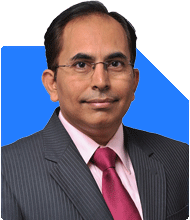Ramalingam Kalirajan |10879 Answers |Ask -Follow
Mutual Funds, Financial Planning Expert - Answered on Jun 09, 2024
He has an MBA in finance from the University of Madras and is a certified financial planner.
He is the director and chief financial planner at Holistic Investment, a Chennai-based firm that offers financial planning and wealth management advice.... more

Hi I sir I a m 52 PSU bank employee. Planning to retire at 55 .Savings of 1 CR in FD .pension expected 60000.Retirement benefits arround 1 CR. Other savings in PLI 15 lacs NSC 10 lacs,LIC 5 lacs Planning to sell 1 property worth 1.5 CR.Daughter pursuing 2nd year . Aged mother and handicapped brother dependant on me. Housing loan 9 lacs outstanding.planning to avail 50 lacs for renovation of another property.Need monthly income if 2 lacs .Please advise investment avenues
You are 52 years old, working in a PSU bank, planning to retire at 55. Your savings include Rs 1 crore in FDs, Rs 15 lakhs in PLI, Rs 10 lakhs in NSC, and Rs 5 lakhs in LIC. You expect a pension of Rs 60,000 and retirement benefits of around Rs 1 crore. You also plan to sell a property worth Rs 1.5 crore. Your dependents include your daughter in her second year of studies, an aged mother, and a handicapped brother. You have an outstanding housing loan of Rs 9 lakhs and plan to borrow Rs 50 lakhs for property renovation. You need a monthly income of Rs 2 lakhs. Here's how to plan your investments to achieve your goals.
Understanding Your Current Financial Position
You have significant assets and income streams, including:
Savings in FD: Rs 1 crore
Expected Pension: Rs 60,000 per month
Retirement Benefits: Rs 1 crore
Property Sale Proceeds: Rs 1.5 crore
Savings in PLI: Rs 15 lakhs
Savings in NSC: Rs 10 lakhs
Savings in LIC: Rs 5 lakhs
Evaluating Your Financial Goals
You aim to secure a monthly income of Rs 2 lakhs post-retirement. This requires careful planning and strategic investments.
Creating a Retirement Corpus
To achieve a monthly income of Rs 2 lakhs, you need to build a substantial corpus. Here’s how to calculate it:
Monthly Income Required: Rs 2,00,000
Annual Income Required: Rs 2,00,000 x 12 = Rs 24,00,000
Assumed Safe Withdrawal Rate: 4%
Required Retirement Corpus: Rs 24,00,000 / 4% = Rs 6 crores
Steps to Achieve the Retirement Corpus
Achieving Rs 6 crores by retirement requires a strategic approach. Here’s a step-by-step plan:
Systematic Investment Plans (SIPs)
SIPs in mutual funds can help build wealth over time. Here’s why:
Regular Investments: Investing monthly promotes disciplined saving.
Rupee Cost Averaging: It averages out the cost of investments, reducing market volatility impact.
Professional Management: Actively managed funds aim to outperform the market.
Building a Diversified Portfolio
Diversification reduces risk and maximizes returns. Here's how to create a balanced portfolio:
Equity Mutual Funds: Allocate a significant portion to equity funds for growth.
Debt Mutual Funds: Invest in debt funds for stability and predictable returns.
Balanced Funds: These funds offer a mix of equity and debt, balancing growth and stability.
Reviewing Existing Investments
You have investments in PLI, NSC, and LIC. These plans typically offer lower returns. Here’s what you can do:
Evaluate Returns: Check the returns on these plans.
Consider Surrendering: If returns are low, consider surrendering and reinvesting in mutual funds.
Utilizing the Proceeds from Property Sale
The sale of your property worth Rs 1.5 crore provides substantial capital. Here’s how to use it:
Pay Off Loans: Clear the Rs 9 lakhs housing loan to reduce liabilities.
Invest the Remaining Amount: Invest the remaining Rs 1.41 crore in a diversified portfolio for growth.
Setting Up a Systematic Investment Plan (SIP)
Determine Monthly Savings: Calculate how much you can invest monthly after expenses.
Select Actively Managed Funds: Choose funds with a strong performance history.
Start Early: The earlier you start, the more time your money has to grow.
Emergency Fund and Insurance
An emergency fund and proper insurance are crucial for financial security. Here’s what you need:
Emergency Fund: Keep 6-12 months' expenses in a liquid fund.
Health Insurance: Ensure you have adequate health coverage for yourself and your dependents.
Life Insurance: Review your life insurance to ensure sufficient coverage.
Benefits of Actively Managed Funds
Actively managed funds are managed by professionals aiming to outperform the market. Here’s why they are beneficial:
Expert Management: Fund managers make informed decisions based on market analysis.
Flexibility: They can adjust the portfolio to mitigate risks.
Potential for Higher Returns: Aiming to outperform the market, these funds often yield higher returns.
Disadvantages of Index Funds
While index funds offer low-cost diversification, they have drawbacks:
Lack of Flexibility: They strictly follow the index, missing opportunities to outperform.
Average Returns: Aim to match market performance, leading to average returns.
Full Market Exposure: They are fully exposed to market downturns without active management.
Disadvantages of Direct Funds
Direct funds have no commission costs but require more involvement. Here’s why regular funds with a CFP are better:
Professional Guidance: Regular funds come with expert advice and management.
Convenience: CFPs handle administrative tasks and provide tailored advice.
Performance Monitoring: Regular reviews by professionals ensure optimal performance.
Planning for Dependents
You have significant responsibilities, including your daughter’s education, and supporting your mother and brother. Here’s how to plan:
Education Fund: Allocate part of your savings for your daughter’s education.
Healthcare Fund: Ensure sufficient funds for your mother’s and brother’s healthcare needs.
Living Expenses: Plan for your brother’s living expenses, ensuring a stable future for him.
Renovation Loan and Its Impact
You plan to borrow Rs 50 lakhs for property renovation. Here’s how to manage it:
Evaluate Necessity: Ensure the renovation is essential and will add value.
Loan Repayment Plan: Create a clear repayment plan to manage the additional debt.
Impact on Savings: Assess how the loan will impact your overall savings and investments.
Creating a Withdrawal Strategy
Having a withdrawal strategy ensures you don’t outlive your savings. Here’s how to create one:
Systematic Withdrawal Plan (SWP): Set up SWPs in mutual funds to provide regular income.
Safe Withdrawal Rate: Withdraw at a safe rate (4%) to ensure the corpus lasts.
Adjust for Inflation: Increase withdrawals periodically to keep up with inflation.
Final Insights
Achieving a monthly income of Rs 2 lakhs post-retirement is challenging but possible. Start with SIPs in actively managed funds, diversify your portfolio, and regularly review and rebalance your investments. Utilize the proceeds from your property sale wisely and plan for dependents' future needs. Ensure you have adequate insurance and an emergency fund. With careful planning and disciplined investing, you can achieve your retirement goals.
Best Regards,
K. Ramalingam, MBA, CFP,
Chief Financial Planner,
www.holisticinvestment.in
You may like to see similar questions and answers below
Sunil Lala | Answer |Ask -Follow
Financial Planner - Answered on Feb 11, 2024
Ramalingam Kalirajan |10879 Answers |Ask -Follow
Mutual Funds, Financial Planning Expert - Answered on Jul 13, 2024
Janak Patel |71 Answers |Ask -Follow
MF, PF Expert - Answered on Jul 07, 2025
Ramalingam Kalirajan |10879 Answers |Ask -Follow
Mutual Funds, Financial Planning Expert - Answered on Jul 09, 2025
Reetika Sharma |417 Answers |Ask -Follow
Financial Planner, MF and Insurance Expert - Answered on Sep 25, 2025
Ramalingam Kalirajan |10879 Answers |Ask -Follow
Mutual Funds, Financial Planning Expert - Answered on Dec 11, 2025
Samraat Jadhav |2507 Answers |Ask -Follow
Stock Market Expert - Answered on Dec 11, 2025
Samraat Jadhav |2507 Answers |Ask -Follow
Stock Market Expert - Answered on Dec 11, 2025
Samraat Jadhav |2507 Answers |Ask -Follow
Stock Market Expert - Answered on Dec 11, 2025
Samraat Jadhav |2507 Answers |Ask -Follow
Stock Market Expert - Answered on Dec 11, 2025
Dr Nagarajan J S K |2577 Answers |Ask -Follow
NEET, Medical, Pharmacy Careers - Answered on Dec 10, 2025
Mayank Chandel |2570 Answers |Ask -Follow
IIT-JEE, NEET-UG, SAT, CLAT, CA, CS Exam Expert - Answered on Dec 10, 2025
Samraat Jadhav |2507 Answers |Ask -Follow
Stock Market Expert - Answered on Dec 10, 2025
Radheshyam Zanwar |6741 Answers |Ask -Follow
MHT-CET, IIT-JEE, NEET-UG Expert - Answered on Dec 10, 2025
Ramalingam Kalirajan |10879 Answers |Ask -Follow
Mutual Funds, Financial Planning Expert - Answered on Dec 10, 2025



























